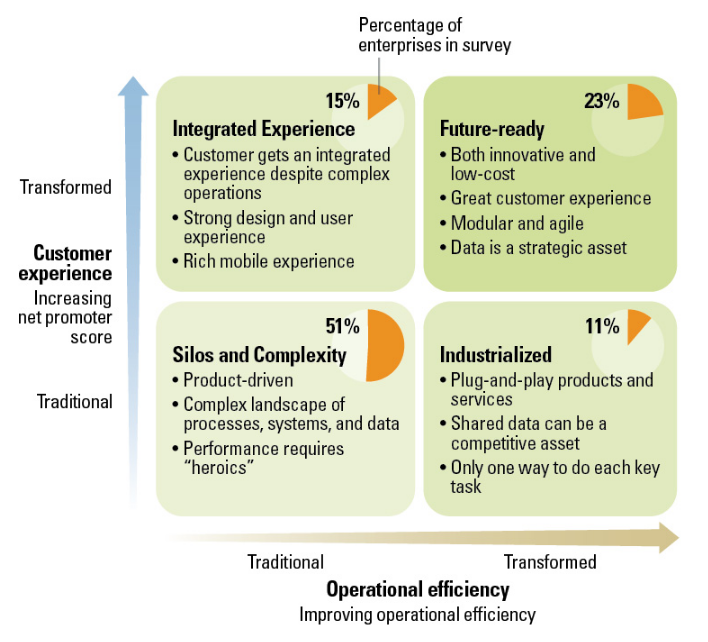In 2015 and 2017, research by Peter Weill and Stephanie L. Woerner surveyed several hundred enterprises, examining both the capabilities needed for digital business transformation and the impacts on performance. Becoming ‘future-ready’ requires changing the enterprise on two dimensions: Customer experience and operational efficiency.
[Update 09.08.18]
Indeed, this chosen pair of dimensions turns out to be highly relevant when it comes to Digital Transformation and innovation. A fresh German study has found:
- 73% of the surveyed senior leaders mention digitalization of processes (largely geared to improve operational efficieny) as a key objective for Digital Transformation in their companies.
- Improving customer experience follows as runner-up with 62%.
- Currently hotly debated topics such as Artificial Intelligence, Blockchain or Addaptive Manufacturing end up only on the back of the digital agenda.
Moreover, new research published at MIT SMR looks at characteristic signs serving as signals that companies or entire industries are about to be disrupted. Two of the identified signs are:
- Customers have to work at managing their costs when purchasing an offering. Implication: Companies are forced to work on its operational efficiency to streamline processes and supply chains, and thereby making its offerings cost-effective for the customers.
- Customers’ experience isn’t positive – or even neutral. Implication: Companies are forced to leverage digital technologies at hand to boost customer experience.
Taken together, by addressing operational efficiency and customer experience in the course of Digital Transformation, companies zero in on two basic pillars for future-readiness which prove essential to prevent the companies (and their respective industries) from being disrupted.
Four pathways to Digital Transformation
By the underlying criteria, 23% of the businesses surveyed were future-ready, shown in the upper-right quadrant of the exhibit below. Their performance averaged 16 percentage points better than their industry average, meaning that if the average net profit margin for a company in a given industry was 8%, future-ready enterprises earned 24%.

Weill and Woerner identified four different pathways that companies took to become future-ready. Each pathway begins in the bottom-left quadrant (Silos and Complexity), and each involves significant organizational disruption:
Pathway 1: Standardize first – moves enterprises from the Silos and Complexity quadrant to the Industrialized quadrant.
Pathway 2: Improve customer experience first – involves moving from the Silos and Complexity to the Integrated Experience quadrant.
Pathway 3: Take stair steps – enterprises move toward becoming future-ready by alternating their focus from improving customer experience to improving operations and then back again, shifting the focus back and forth as needed.
Pathway 4: Create a new organization – rather than fight an uphill battle to transform their existing organization, leaders who choose to pursue Pathway 4 start new enterprises that begin life as future-ready.
The suitable pathway to Digital Transformation is company-specific
The adequate approach will depend on the company’s context, the industry environment, and the objectives executive management wants to achieve:
- Pathway 1 makes sense if the customer experience the company provides is around industry average and the threat of digital disruption is not high. CIOs are a good choice to lead Pathway 1.
- Pathway 2 makes sense if the customer experience the company provides is significantly worse than average and you can’t wait to improve, or if there are worrisome new competitors. An executive passionate about customer experience who is technologically literate is a good choice to lead Pathway 2.
- Pathway 3 makes sense if the customer experience the company provides is a problem, but you can identify a few limited initiatives that will make a big difference. Start with those and then focus on operations – and repeat in small steps. A chief digital officer is a good choice to lead Pathway 3.
- Pathway 4 – building a new enterprise – makes sense when you can’t see a way to change the culture or the customer experience and operations fast enough to survive. The CEO or COO are good choices to lead Pathway 4.
For further, worthwile details of this research I recommend reading the entire article at MIT Sloan Management Review.
One Response to Digital Transformation Combines Customer Experience and Operational Efficiency